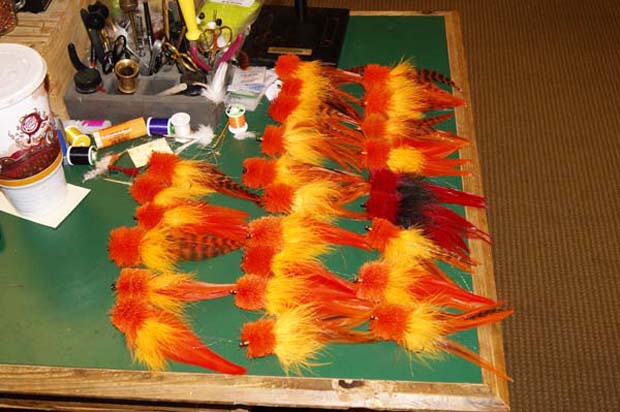
You can use any color fly to catch a spinner, as long as it’s orange. Flies are 6- to 8-inches long and bushy. Grant Gisondo photo.
By Grant Gisondo with Sidebar by Norman Duncan
On a gray Sunday afternoon in February – sitting at my desk, I witness the first of several cold fronts roll into South Florida. The temperature dropped 15 degrees in a matter of a few hours. The wind switched from 20 miles per hour out of the northeast to a steady 10 miles per hour out of the northwest.
It means the spinner sharks are here and active! But what I don’t know is, does a northwest wind after a cool front passes change the hordes of spinner sharks from breeding mode to feeding mode? Now I understand.
What does this mean for fly fishing in the Jupiter and Palm Beach area?
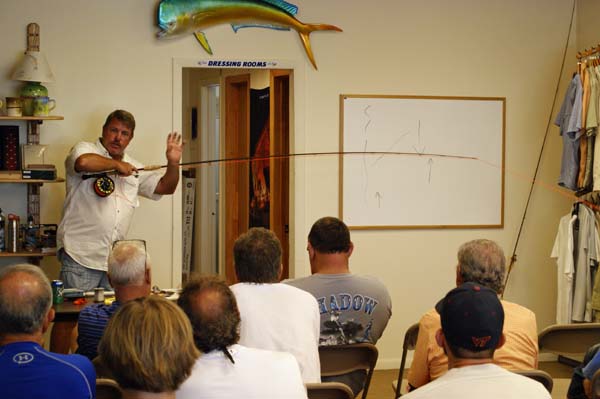
Capt, Scott Hamilton demonstrating techniques. Notice rod he uses has a fighting grip and it’s a 14-weight. Some big female spinners are over 100-pounds and make a 100-pound tarpon feel like a goldfish in comparison. Gisondo photo.
I attended Capt. Scott Hamilton’s Fly Fishing Extremes lecture at Ole Florida Fly Shop . Capt. Scott spent the better part of two hours discussing the most intimate secrets and tactics of successfully catching spinner sharks on a fly. Scott virtually invented the techniques and flies and is credited by every legitimate area captain as the guru of spinners on a fly.
NOTE: Some years they’re scant few and in other years tens of thousands to well north of Vero Beach, but the Palm Beaches seems always to be Mecca.
Capt. Scott captivated a small group of maybe a dozen of us with his knowledge of every aspect of fly fishing for spinners: flies, tackle, knots, leaders, locating fish, fighting techniques, safely landing, and releasing these energetic sharks. The best part about it is that all this action takes place in around 25-feet of water, so the need for large boats and large amounts of fuel is eliminated – this is great because fuel prices are not gas engine friendly for boaters.
Ole Florida Fly Shop, owned and managed by Darren Selznick, is located in Boca Raton and serves the region as a one-stop-shop for the fresh and saltwater fly fishers. Darren’s shop has an entire room dedicated to fly tying materials, flies, rods, reels, and terminal tackle – the other space dedicated to clothing that a traveling angler would need.
After Capt. Scott’s lecture, I was ready to get out there and make some casts for these fish. Darren took the time to set me up with all the tying materials I needed to tie up some of Scott’s shark flies. I was out the door and on my way to my marina.
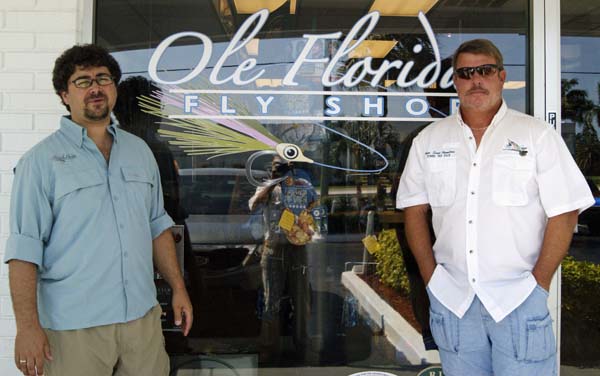
Darren, on the left, (proprietor of Ole Florida Fly Shop) and Capt. Scott Hamilton pose for Grant Gisondo post spinner lecture.
It was a fun, educational, and enjoyable Saturday based around a remarkable fishery. I would personally like to offer a personal thank you to Capt. Scott for providing his knowledge on the subject and Darren for running a great fly shop.
For those of you who would be interested in learning about fly fishing for spinners in the Palm Beach area, I strongly advise contacting Scott. Book him as soon as possible and give it a try – learn the ropes, even if you have a boat because running over any fish in shallow water ruins a fishery faster than you can say sh&t. Scott has a long list of repeat clients from all over the US, Canada, and south of the border.
Why are shark flies always bright orange?
Florida angling legends Norman Duncan, John Emery (deceased), Chico Fernandez, and Flip Pallot attended the University of Miami in the early 1960s. They have become legends fly fishing in South Florida, the Keys.
Norman invented the Duncan Loop, which was renamed the uni-knot by an outdoor writer. He also invented the “Outside Fly,” which later became known as the Deceiver.
Sidebar by Norman Duncan – the origin of orange
Around 1955, John Emery came into the tackle store where I worked building custom rods and repairing reels. Since he was also interested in fly fishing, we became fishing buddies. We would take his Triumph TR3 or my Volvo PV544 and drive out the Tamiami Trail to fish the canals on the west coast or go down to the Florida Keys to fish roadside flats and canals in new housing developments. Occasionally, if we headed back early in the afternoon, we would stop at the roadside just north of the Jewfish Creek Bridge to wade the flats along Barnes Sound.
At that time, there was a fish house on pilings out in the Barnes Sound called “Manatee Smoked Fish,” they also sold fresh fish and turtle meat. We found that they slaughtered the turtles and fish, then at night threw the carcasses out the back door into the sound. We could see the small bonnet and lemon sharks cruising these beautiful white sandy flats, even driving by. We would buy the best-smoked fish from their market and find out when they would dump a load.

Shark flies tied by Grant Gisondo. Gisondo image.
While fishing the canals and channels, we often used the orange/yellow streamer fly that had been recently developed for tarpon by Kay Brodney and Jim Adams; usually, we tied a shock leader on the tippet, sometimes with wire. If we didn’t re-rig, we would use some of these same flies when we waded these flats. We soon found that the sharks and barracudas would respond best to the orange/red flies; we thought these colors best imitated the carnage they were feeding on from the smokehouse. At about this time, I read a report that the US Navy had tested several different life rafts out in the ocean by dropping them all well offshore. When they came back a week later, they found that the rafts from one of the manufacturers had one side ripped apart apparently by sharks. It turned out that this manufacture had their specifications written on an orange patch at the waterline! John and I were not at all surprised at this finding.
In the early 1960s, Little John and I joined some of the local fishing clubs; the members were keen on learning as much as they could about all aspects of light tackle fishing, especially saltwater fly fishing. When the subject of how to get the ordinarily nearsighted sharks to respond to a fly, we recommended using orange/red streamer flies since we found them the most effective. At this time, I caught my first sizable barracuda (9-pounds) with this orange fly while wading the flats behind Big Torch Key. From there, this concept took off in the fly fishing circles, although I still don’t know for sure if Little John and I were the ones to first introduce this fly pattern to saltwater fly fishing.
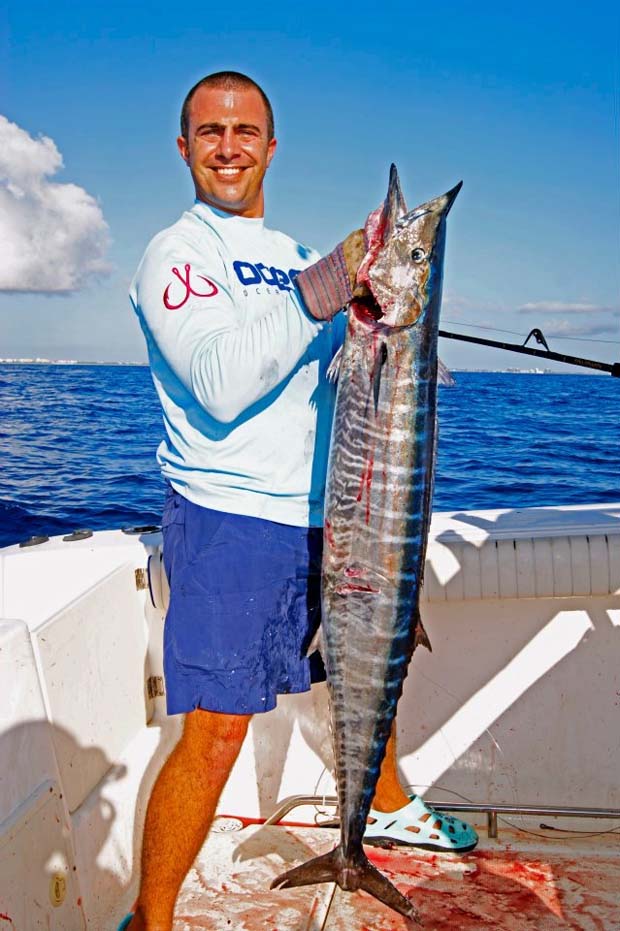
And there was another day. Grant with a nice ‘hoo’. Photo credit Grant Gisondo. You can email Grant at grantgisondo@gmail.com


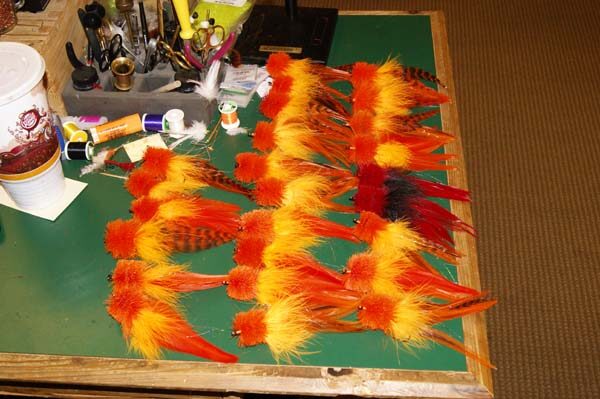
Join the discussion One Comment